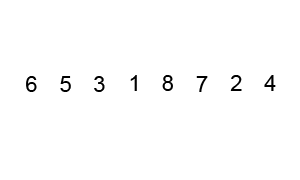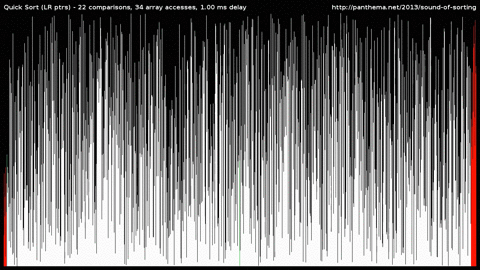Quick Sort Algorithm
May 19, 2019
This algorithm is very useful for large input. And, is quite efficient one. It has several implementation, and it is proved that for practical cases, it is better than Merge Sort, Heap Sort any many other algorithms. Although, its worst complexity is O(n^2).
This is again an implementation of of Divide and Conquer algorithms. In this algorithm, we first find a pivot element, put it in a position such that every element in left is less than or equal than this. And every element on right side is greater than equal than this number.
So, this pivot element divides the array into two parts. Then, natural recursive algorithm work on individual smaller arrays. Note: It is very important to choose correct pivot element. This algorithm works best when pivot element divides the array into almost equal halves. That is the reason, there are several implementations are available for selecting pivot element.
In a simple implementation, we simply choose the last element as pivot. Some algorithms choose a random pivot element.
Quick Sort Algorithm
- First, we call partition on the array, where lies the main logic of putting the pivot element to correct position.
- Pivot element divides the array into two partitions.
- Now, runs the recursive method on the two partitions.
- Ultimately, partition sorts the sub-array.
See the code here:
public static int partition(int[] arr, int l, int r) {
int p = r; //pivot
int sm = l;
for (int i=l; i<r; i++) {
if (arr[i] < arr[p]) {
ArrayUtils.swap(arr, i, sm);
sm++;
}
}
ArrayUtils.swap(arr, sm, p);
return sm;
}
public static void qsort(int[] arr, int l, int r) {
if (l < r) {
int p = partition(arr, l, r);
qsort(arr, l, p-1);
qsort(arr, p+1, r);
}
}The main logic resides in partition() method. We just kept an index variable: sm which keeps track of all smaller number than our pivot element. And, finally swap our index sm and pivot element index.
Graphical Example


Key Points
- It does not use extra memory.
- Very efficient in sorting large number set.
- Practically best performer than merge sort, if implemented better for selecting pivot element.
- Performance is very good. Average complexity is O(n log n)
- Based on Divice and Conquer technique
- It works well in virtual memory environment
Runtime complexity
The average runtime is O(n log n), but worst case is O(n^2)
Similar Posts
Leetcode - Split a String Into the Max Number of Unique Substrings
Problem Statement Given a string s, return the maximum number of unique…
Maximum Length of Subarray With Positive Product - Leet Code Solution
Problem Statement Maximum Length of Subarray With Positive Product. Given an…
Binary Search Tree (BST) Data Structure
A Binary Search tree (BST) is a data structure which has two children nodes…
Single Number - Leet Code Solution
Problem Statement Given a non-empty array of integers, every element appears…
Reverse digits of a signed integer - Leet Code Solution
Problem Statement Given a signed integer, reverse digits of an integer. Return…
Latest Posts
Jenkins Pipeline with Jenkinsfile - How To Schedule Job on Cron and Not on Code Commit
Introduction In this post we will see following: How to schedule a job on cron…
How to Git Clone Another Repository from Jenkin Pipeline in Jenkinsfile
Introduction There are some cases, where I need another git repository while…
How to Fetch Multiple Credentials and Expose them in Environment using Jenkinsfile pipeline
Introduction In this post, we will see how to fetch multiple credentials and…
Jenkins Pipeline - How to run Automation on Different Environment (Dev/Stage/Prod), with Credentials
Introduction I have an automation script, that I want to run on different…
Jenkinsfile - How to Create UI Form Text fields, Drop-down and Run for Different Conditions
Introduction I had to write a CICD system for one of our project. I had to…
Java Log4j Logger - Programmatically Initialize JSON logger with customized keys in json logs
Introduction Java log4j has many ways to initialize and append the desired…